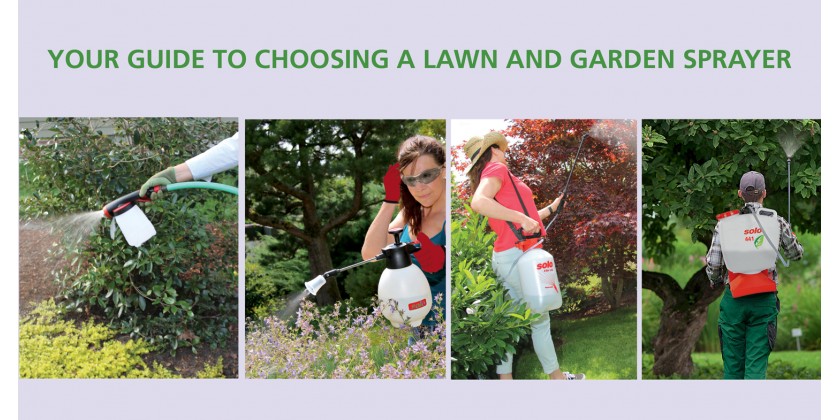
Each sprayer type is built for use with various job sizes and chemicals. Understanding the different sprayer types, how they function, and their intended use is critical when choosing a sprayer.
SPRAYER TYPES
Let’s start with sprayer types. Knowing the difference between each sprayer type will help you determine which sprayer is best for what you’re trying to accomplish. Each sprayer type works similarly but varies in size and function. Solo offers four sprayer types:
Hose-end
One-hand
Handheld or tank
Backpack
Hose-end
Hose-end sprayers are one of the most common and household-friendly sprayers. A hose-end sprayer attaches to a hose, siphons the product, and mixes it with water as it sprays.
Solo’s 405-H adaptable hose-end sprayer has an adaptable cap that can fit directly on the most popular bottles of chemical concentrates. When using Solo’s 405-HE sprayer, you don’t have to mix, measure, or pour chemical solutions. If you find that your hose-end sprayer’s cap doesn’t fit on the bottle, you can use it as a traditional hose-end sprayer.
Job type:
- Spraying liquid herbicides, pesticides, fungicides, and liquid fertilizers.
One-Hand
One-hand sprayers are versatile, lightweight sprayers ideal for spot treating or spraying smaller areas and come in sizes ranging from one to two liters.
Some one-hand sprayers are more specialized than others. For example, Solo has a range of one-hand sprayers, from home and garden to janitorial sanitation. Solo’s home and garden sprayers offer the same high-quality manufacturing as our professional sprayers but are more economically priced. Solo’s professional one-hand sprayers, like our CLEANLine sprayers, are built for the professional user and are designed to withstand harsher chemical solutions.
To use a one-hand sprayer, pour a mix of water and chemical and pump the sprayer to pressurize. Many one-hand sprayers come with a lock-on/off mechanism for continuous spraying to reduce finger fatigue and adjustable nozzles to change the spray pattern from a mist to a jet stream to fit different spraying tasks.
Job type:
- Spraying fertilizers, herbicides, and pesticides
- Cleaning tires and tire rims
- Applying fly spray to livestock or horses
- Watering indoor plants
- Spot-treating carpet stains
Handheld or Tank
Handheld sprayers, also known as tank sprayers, are one of the most common sprayer types. Tank sprayers are usually available in 1-gallon to 3-gallon sizes.
Tank sprayers use their pump to force air into their tank, and the user must pump the sprayer a certain number of times to pressurize the tank. Solo’s tank sprayers are built with a large pump handle and shut-off valve with a lock-on/off feature for operator comfort. Users also have multiple spraying options. Solo’s tank sprayers come with a variety of nozzles for different spraying tasks
Using a handheld sprayer is like using a one-hand or backpack sprayer, where you mix chemicals and water into the tank and pump to pressurize.
A handheld or tank sprayer is ideal for small or medium-sized spraying jobs, like:
- Applying fertilizers and herbicides to small or medium-sized yards.
- Spraying pesticides and insecticides
- General-purpose spraying
Backpack
A backpack sprayer is designed for large spraying jobs and is popular among landscaping professionals and lawn care hobbyists because of its large tank capacity and extended wand. There are two types of backpack sprayers: manual and powered.
Manual
Manual backpack sprayers require the user to manually pump the sprayer to pressurize and come with two pump types: piston and diaphragm.
Piston
- Piston pumps move up and down to create pressure.
- Piston pumps can pressurize up to 90 psi.
- A piston pump is best for use with low abrasive or low viscosity liquids like herbicides and pesticides.
- Easy to maintain and repair
Diaphragm
- Diaphragm pumps flex up and down to create pressure.
- Diaphragm pumps can pressurize up to 60 psi.
- Diaphragm pumps are repairable but more time-consuming.
- Diaphragm pumps are best for use with wettable powders, abrasive liquids, bleach, or using water from wells, lakes, and streams that may have small particles of grit.
- Use a diaphragm pump sprayer for spraying bleach or wettable powder solutions as well as liquid formulations.
Powered
Powered backpack sprayers are growing in popularity because they don’t require you to pump. There are two types of powered sprayers: battery and motorized.
Battery
Battery-powered sprayers are ideal for spraying larger areas and might help professional landscapers to spray liquid products longer. You can find a battery-powered sprayer in different tank sizes. One-hand battery-powered sprayers might be ideal for misting large quantities of houseplants, spraying weeds, or cleaning and disinfecting. You might consider a battery-powered backpack sprayer for spraying in greenhouses or enclosed office spaces, for covering bigger yards or spraying many yards quickly.
Battery-powered sprayers:
- Powered by a lithium-ion battery
- Run time of at least 1 hour for one-liter sprayers and 2.5 or more hours for four and five-gallon sprayers.
- Must be charged after use
- Tank capacity varies from 1-liter to 5 gallons
- Can be used for small and large jobs
Motorized
Motorized backpack sprayers are powerful tools for professionals who need to spray a fine mist at extreme distances. Solo’s 433 motorized backpack sprayer can reach a psi as low as 14.5 psi and as high as 435 psi. Solo’s motorized backpack sprayer is fuel-efficient and runs on gasoline, so there is no need to mix gas and oil. As a result, there is less smoke and odor.
Motorized sprayers:
- Powered by a 4-stroke Honda engine
- Do not have to be charged because they run on gasoline
- Large tank capacity
- For large, professional spraying that requires high operating pressure
Choose the Right Sprayer for the Job
Product selection is critical. Taking the time to choose a sprayer based on the chemical you plan to use and the size of the job will help you pick the best sprayer for your needs.
